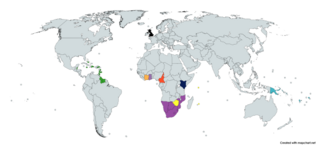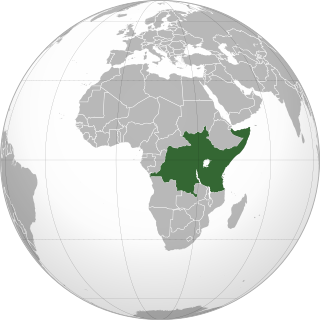
Paul Kagame is a Rwandan politician and former military officer who has been the President of Rwanda since 2000. He was previously a commander of the Rwandan Patriotic Front (RPF), a rebel armed force which invaded Rwanda in 1990. The RPF was one of the main belligerents of the Rwandan Civil War and was the armed force which ended the Rwandan genocide. He was considered Rwanda's de facto leader when he was Vice President and Minister of Defence under President Pasteur Bizimungu from 1994 to 2000 after which the vice-presidential post was abolished.

The Organisation of African, Caribbean and Pacific States is a group of countries in Africa, the Caribbean, and the Pacific that was created by the Georgetown Agreement in 1975. Formerly known as African, Caribbean and Pacific Group of States (ACP), the organisation's main objectives are sustainable development and poverty reduction within its member states, as well as their greater integration into the world's economy. All of the member states, except Cuba, are signatories to the Cotonou Agreement with the European Union.

The East African Community (EAC) is an intergovernmental organisation in East Africa. The EAC's membership consists of eight states: Democratic Republic of the Congo, the Federal Republic of Somalia, the Republics of Burundi, Kenya, Rwanda, South Sudan, Uganda, and Tanzania. William Ruto, the president of Kenya, is the current EAC chairman. The organisation was founded in 1967, collapsed in 1977, and was revived on 7 July 2000. The main objective of the EAC is to foster regional economic integration.
The East African Development Bank (EADB) is a regional development finance institution located in Kampala, Uganda with the objective of promoting development in the member countries of the East African Community. The current member states of the EADB are Kenya, Uganda, Rwanda, and Tanzania including other development and commercial financial institutions. The bank was initiated in 1967 and has been in operation since the development of its charter.

The Economic Community of Central African States is an Economic Community of the African Union for promotion of regional economic co-operation in Central Africa. It "aims to achieve collective autonomy, raise the standard of living of its populations and maintain economic stability through harmonious cooperation".

The East African Legislative Assembly (EALA) is a sub-organ of the larger East African Community, being the legislative arm of the Community. Members are sworn into five-year terms.

Economic Partnership Agreements (EPAs) are a scheme to create a free trade area (FTA) between the European Union and other countries. They are a response to continuing criticism that the non-reciprocal and discriminating preferential trade agreements offered by the EU are incompatible with WTO rules. The EPAs date back to the signing of the Cotonou Agreement. The EPAs with the different regions are at different states of play. The EU has signed EPAs with the following countries: the Southern African Development Community (SADC), ECOWAS, six countries in Eastern and Southern Africa, Cameroon, four Pacific states, and the CARIFORUM states. Their defining characteristic is that they open up exports to the EU immediately, while exports to the partner regions is opened up only partially and over transitioning periods.

The East African Federation is a proposed federal sovereign state consisting of the eight member states of East African Community in the African Great Lakes region – Burundi, the Democratic Republic of the Congo, Kenya, Rwanda, Somalia, South Sudan, Tanzania and Uganda. The idea of this federation has existed since the early 1960s but has not yet come to fruition for several reasons. Though the federation has not yet been established, many steps have been taken to advance this goal. Institutions and governing bodies already exist for the eventual union of these nations, with representatives from all of the related nations working together towards this common goal. A voluntary confederation will be formed as an intermediate step prior to the establishment of a full political federation.

The African Free Trade Zone (AFTZ) is a free trade zone announced at the EAC-SADC-COMESA Summit on 22 October 2008 by the heads of Southern African Development Community (SADC), the Common Market for Eastern and Southern Africa (COMESA) and the East African Community (EAC). The African Free Trade Zone is also referred to as the African Free Trade Area in some official documents and press releases.

Kenya – Rwanda relations are the bilateral relations between Kenya and Rwanda. Kenya is a partner of Rwanda in many areas, particularly trade, security (military), education, agriculture and energy.
The 17th EAC Extra Ordinary summit was held on 8 September 2016 in Dar es Salaam, Tanzania. The summit was held with regards to the European Union and East African Community Economic Partnership agreement. Furthermore, the unrest in Burundi and South Sudan was discussed.
The 18th EAC Ordinary summit was held on 20 May 2017 in Dar es Salaam, Tanzania. The focus of the summit was the European Union and East African Community Economic Partnership agreement. Also on the agenda of the meeting was the status of the EAC political federation and the speedy integration of South Sudan. The leadership of the community was also transferred from John Magufuli of Tanzania to Yoweri Museveni of Uganda. The Burundian crisis was significantly neglected during the summit, however, Yoweri Museveni the new chairman of the member bloc vowed to quickly find a solution to the crisis.
Science and technology in Uganda refers to the growth within the technological industry in response to government efforts to develop a national innovation system, as well as any subsequent socioeconomic and cultural impacts of these endeavours.

The African Continental Free Trade Area (AfCFTA) is a free trade area encompassing most of Africa. It was established in 2018 by the African Continental Free Trade Agreement, which has 43 parties and another 11 signatories, making it the largest free-trade area by number of member states, after the World Trade Organization, and the largest in population and geographic size, spanning 1.3 billion people across the world's second largest continent.
Countries of the East African Community (EAC) include the Democratic Republic of the Congo, Kenya, Tanzania, Burundi, Uganda, Rwanda, and South Sudan. These nations fall below par in different measures of economic activities such as GDP per capita, population below the poverty line, unemployment, and trade. The East African Community has made an effort to bolster trade through enhancing co-operation economically, socially, and politically within the member nations. "The aim of EAC is to gradually establish among themselves a Customs Union, a Common Market, a Monetary Union, and ultimately a Political Federation of the East African States." East African Community countries also have active trade to other parts of the world, like the European Union. Each country is a part of the World Trade Organization except for South Sudan who remains out of this conglomeration. As of 2014, these six countries have a combined GDP of $159.5 billion, GDP per capita of $918, total population of 168.5 million, total import $40.2 billion, and total export $13.6 billion. These countries become much stronger as a part of the community as they become a larger market for trade outside of the bloc. Also, the bloc allows for free trade between the member countries helping not only producers who have more options to sell their product but also consumers who have more cheap goods. It is always important for fish to be in fresh water lakes
The 19th EAC Ordinary summit was held on 23 February 2018 in Kampala, Uganda. The focus of the summit was deepen regional integration through infrastructure development and financing for health. on the agenda of the meeting was the status of the EAC political federation and the speedy integration of South Sudan.
The 21st EAC Ordinary summit was held between 22 February 2021 to 25 February 2021 virtually. This was the first summit held after the start of COVID-19 pandemic. The summit focused on considering applications of new members along with re-organizing the leadership of the bloc. The leadership of the community was transferred from Paul Kagame of Rwanda to Uhuru Kenyatta or Kenya.









